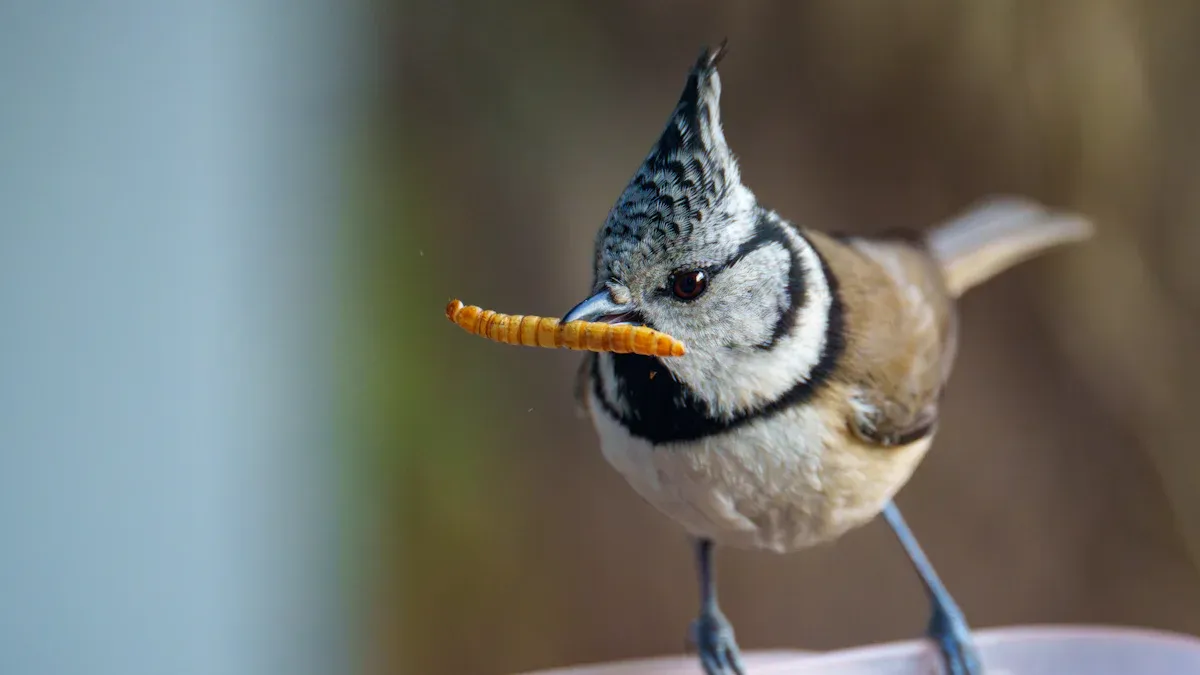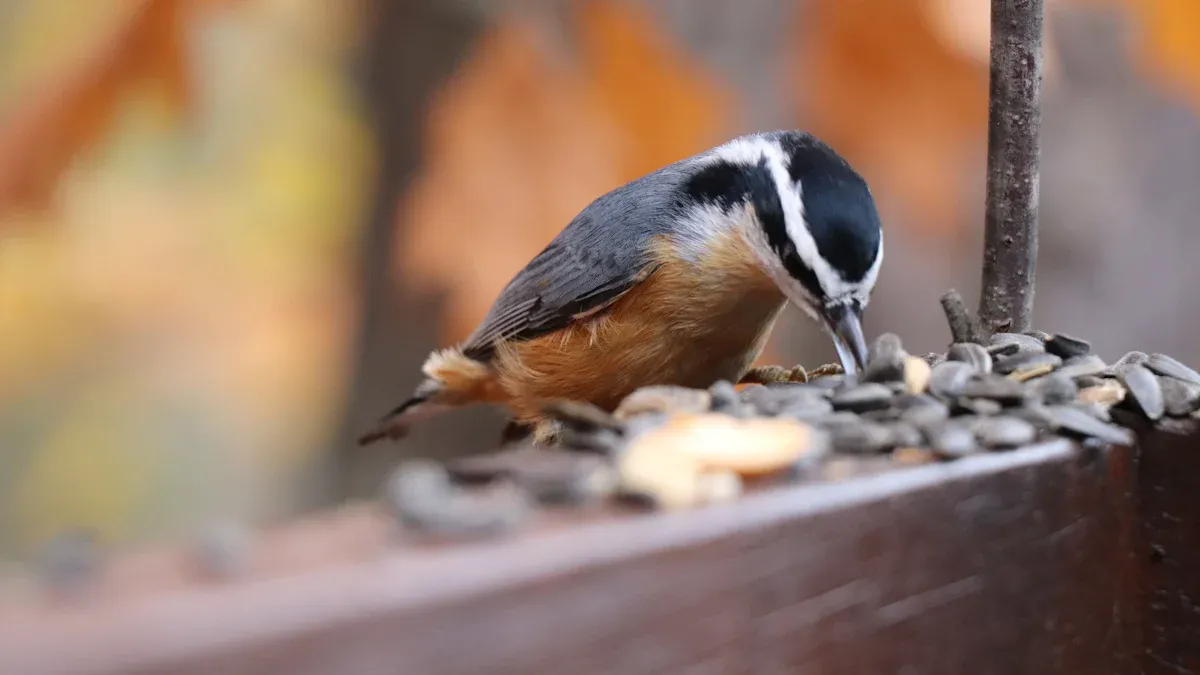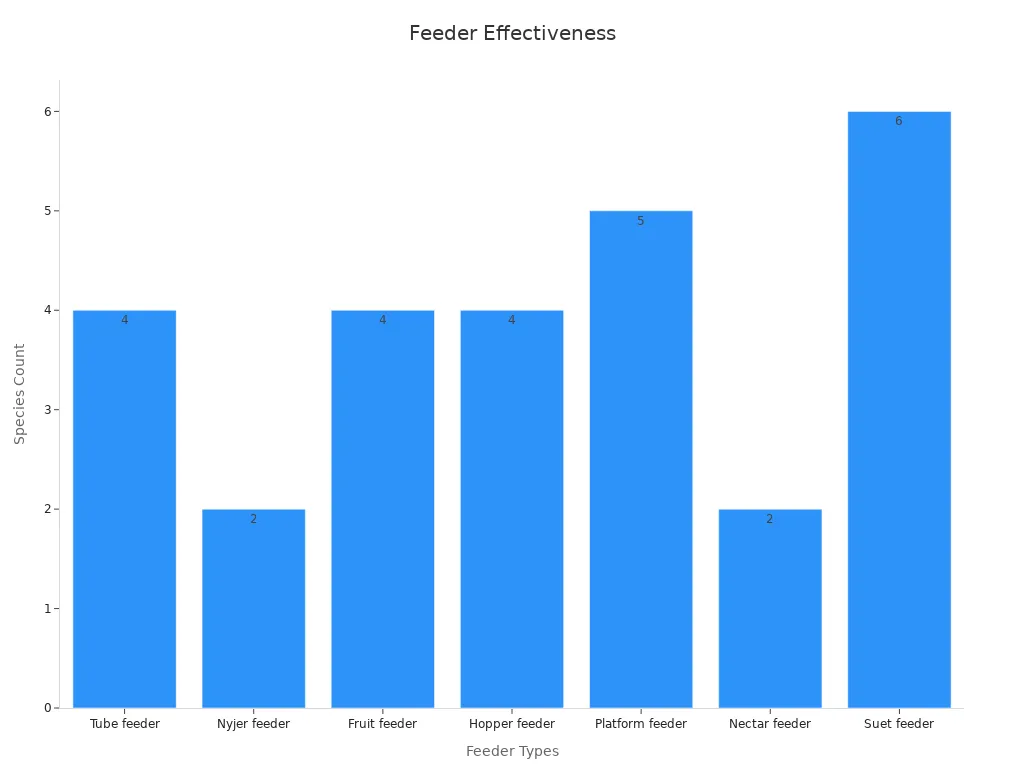
People often wonder if mealworms for wild birds are safe and helpful. Studies show that mealworms provide high protein and fat, which wild birds need. When raised on special diets, mealworms offer even more nutrients for birds. Our dried mealworms attract many bird species and help them stay healthy year-round.
Key Takeaways
- Mealworms provide wild birds with high protein and fat, essential for energy, growth, and health, especially during breeding, migration, and winter.
- Offering mealworms in moderation, mixed with seeds and fruits, supports a balanced diet and attracts many bird species to your yard.
- Store dried mealworms in a cool, dry place and clean feeders regularly to keep birds safe and healthy while enjoying this nutritious food.
Mealworms for Wild Birds: What They Are

Understanding Mealworms as Bird Food
Mealworms are the larval stage of the beetle Tenebrio molitor. People have used them for years as food for wild birds, reptiles, and even fish. These small, wiggly insects are easy to breed and come in both live and dried forms. Many bird lovers choose mealworms because they attract a wide variety of birds, such as bluebirds, chickadees, and robins.
Bird experts explain that mealworms fit naturally into a bird’s diet. Birds eat insects in the wild, so mealworms feel familiar and appealing. Some people worry about safety, but experts confirm that birds can digest mealworms without problems. Songbirds even have a way to get rid of parts they cannot digest by regurgitating pellets, just like raptors do. This natural process keeps birds safe and healthy.
Tip: Dried mealworms are easy to store and can be mixed with regular bird seed or offered alone. They last longer than live worms and require less care.
Nutritional Profile of Mealworms
Mealworms for wild birds offer a balanced mix of nutrients. On a fresh weight basis, mealworm larvae contain about 64% moisture, 14% fat, and 18% protein. When dried, these numbers change to about 38% fat and 49% protein. Mealworms also provide important minerals like phosphorus, magnesium, potassium, zinc, and manganese. Some even contain omega-3 fatty acids, which help keep birds’ feathers and bodies healthy.
Here’s a quick look at the nutritional breakdown:
| Nutrient | Fresh (%) | Dried (%) |
|---|---|---|
| Protein | 17.6 | 49.1 |
| Fat | 13.8 | 38.3 |
| Moisture | 64.1 | — |
| Carbohydrate | 3.1 | 8.5 |
| Ash (minerals) | 1.5 | 4.1 |
These numbers show why mealworms are a safe and nutritious choice for wild birds in 2025. Bird experts and rehabilitators agree that mealworms do not cause harm and help support healthy, active birds.
Nutritional Benefits of Mealworms for Wild Birds

Protein, Fat, and Moisture Content
Mealworms pack a powerful punch when it comes to nutrition. Birds need protein to build strong muscles and feathers. Fat gives them energy, especially when food is hard to find. Moisture helps keep birds hydrated and healthy. Mealworms offer all three in impressive amounts.
Researchers have compared the nutrition in mealworms raised on different diets. The table below shows how their protein, fat, and moisture levels stack up:
| Nutrient | Control Diet (Dry Matter Basis) | Potato Cuttings (Wet Feed) | Fermented Chicory Roots (Wet Feed) |
|---|---|---|---|
| Moisture | 72% | Not specifically changed | Not specifically changed |
| Protein | 51% | Decreased | Not significantly changed |
| Fat (Lipid) | 19% | Doubled (approx. 38%) | Not significantly changed |
| Ash | 5% | Not significantly changed | Increased by 1.5 times (~7.5%) |
Mealworms grown on a standard diet contain about 51% protein and 19% fat on a dry matter basis. When fed potato cuttings, their fat content can double, reaching around 38%. This high fat and protein content makes mealworms a top choice for wild birds that need quick energy and strong bodies.
Note: Our 1kg bag of dried mealworms is rich in protein and calories. You can add them to any seed mix or offer them alone. Many bird species love them, and they help keep birds healthy all year.
Supporting Birds During Breeding, Migration, and Winter
Birds face tough times during breeding, migration, and winter. They need extra energy and nutrients to survive and thrive. Mealworms for wild birds provide just what they need.
During breeding season, birds use protein from mealworms to build eggs and feed their chicks. Fat gives them the energy to find food and protect their nests. When birds migrate, they travel long distances and burn lots of calories. Mealworms help them refuel quickly. In winter, food can be scarce. Mealworms offer a reliable source of calories and nutrients, helping birds stay warm and active.
Scientists have studied how birds use mealworms during these important times. For example, western bluebirds share mealworms with each other in winter and while raising young. Researchers watched how often birds fed together and measured how much mealworm each bird ate. They found that mealworms help birds survive cold weather and support social bonds in the flock.
Tip: Offering mealworms during breeding, migration, and winter can make a big difference for your local birds. Place them in a feeder, on a bird table, or even on the ground to attract a wide variety of species.
Live vs. Dried Mealworms for Wild Birds
Nutritional Differences
Live and dried mealworms both offer great nutrition for wild birds. Live mealworms contain more moisture, which helps birds stay hydrated. Dried mealworms have less water but higher concentrations of protein and fat by weight. Some nutrients can change during drying. For example, heat from drying or cooking may cause a small loss of vitamins and can lead to fat oxidation. Freeze drying helps keep more nutrients, but some fat oxidation may still happen. Newer methods, like high-pressure processing, can help preserve even more nutrition. Both live and dried mealworms for wild birds remain excellent sources of protein and energy.
Bird Preferences and Attraction
Birds often show strong preferences between live and dried mealworms. Many insect-eating birds, such as bluebirds and robins, love the movement of live mealworms. The wiggling attracts their attention and encourages natural hunting behaviors. Dried mealworms, on the other hand, are easy to offer and still attract a wide range of species. Some birds may need time to get used to dried mealworms, but mixing them with seeds or soaking them in water can help. Both types can bring more birds to your yard, especially during busy seasons.
Storage and Handling
Storage and handling play a big role in keeping mealworms fresh and safe. Live mealworms need a cool, dry place and regular care. Dried mealworms are much easier to store. They last longer and do not need special conditions. Studies show that storing mealworm products at very cold temperatures, like −21 °C, keeps them fresh for months. Warmer storage, such as 4 °C, may lead to spoilage in just a few weeks. Even with preservatives, dried mealworms can spoil if not stored properly. Fat oxidation can happen over time, so keeping mealworms in a cool, dry spot helps maintain their quality. Fermentation is another way to keep mealworms safe for longer periods.
Tip: Our 1kg bag of dried mealworms is easy to store and perfect for mixing with seeds or using alone. They attract many bird species and help keep birds healthy all year.
How to Feed Mealworms for Wild Birds Responsibly
When and Where to Offer Mealworms
Feeding wild birds can be rewarding, but timing and location matter. Birds need extra protein and energy during certain times of the year. Spring and summer are the best seasons to offer mealworms. Birds work hard to build nests, lay eggs, and feed their chicks. Mealworms give them the boost they need to stay strong and healthy.
A quick look at seasonal feeding:
| Season | Recommended Foods Including Mealworms |
|---|---|
| Spring | High protein feed including mealworms, seed blends, sunflower seeds, millet, fresh fruit, suet (when dry), nectar, peanut butter, crushed eggshells |
| Summer | High protein feed including mealworms, seed blends, sunflower seeds, Nyjer seeds, millet, nectar, fruit, jelly, peanuts, suet |
| Fall | High fat feed for migration preparation; mealworms not specifically listed, but seeds, nuts, fruit, suet recommended |
| Winter | High energy, high fat feed; mealworms not specifically listed, but seeds, nuts, suet, cheese, fruit, peanut butter recommended |
Birds also benefit from mealworms during migration and molting. In winter, insect-eating birds like woodpeckers and robins need extra help to stay warm. Place feeders in quiet spots, away from busy roads and predators. Near shrubs or trees works well, giving birds a safe place to perch.
Tip: Offer mealworms in the morning and late afternoon when birds are most active. This helps them refuel after a long night or before sunset.
Feeder Types and Placement
Choosing the right feeder makes a big difference. Different birds like different feeders. Tube feeders, platform feeders, and suet feeders all attract unique species. For mealworms, platform feeders and special mealworm feeders work best. These feeders let birds see and reach the mealworms easily.
Here’s a table showing which feeder types attract certain birds:
| Bird Species | Preferred Feeder Types |
|---|---|
| American Goldfinch | Tube feeder, Nyjer feeder |
| Eastern Bluebird | Fruit feeder |
| House Finch | Tube feeder, Hopper feeder, Platform feeder, Fruit feeder |
| Jay | Hopper feeder, Platform feeder |
| Northern Cardinal | Hopper feeder, Platform feeder, Suet feeder |
| Nuthatch | Tube feeder, Suet feeder |
| Oriole | Nectar feeder, Fruit feeder |
| Song Sparrow | Platform feeder |
| Titmouse | Tube feeder, Hopper feeder, Platform feeder, Suet feeder |
| Warbler | Suet feeder |
| Woodpecker | Suet feeder, Fruit feeder |
| Wren | Suet feeder |
Platform feeders placed close to the ground attract doves, juncos, and sparrows. Higher platforms bring in finches and cardinals. Tube feeders with small ports work well for finches. Suet feeders attract woodpeckers and chickadees. Offering a mix of feeder types brings more birds to your yard.

Note: Our 1kg bag of dried mealworms can be used in mealworm feeders, on bird tables, or even sprinkled on the ground. This flexibility helps attract a wide variety of wild birds.
Best Practices for Balanced Feeding
Mealworms for wild birds provide excellent nutrition, but balance is key. Birds need a mix of foods to stay healthy. Scientists recommend offering only a few mealworms per bird—about 1 to 10 each. This small amount gives birds a protein boost without replacing their natural diet.
Here are some best practices for balanced feeding:
- Offer mealworms during spring and summer when birds need extra protein for breeding and raising chicks.
- Use mealworms as a supplement, not the main food. Mix them with seeds, fruits, and nuts.
- Watch how much birds eat. Too many mealworms can lead to an unbalanced diet.
- Clean feeders often to prevent mold and disease.
- Provide fresh water nearby for drinking and bathing.
A balanced diet for wild birds includes:
- High-protein foods like mealworms, especially for baby birds and during molting.
- Seeds, nuts, and fresh fruits such as apples, berries, and grapes.
- Occasional supplements like calcium and vitamin D3 for strong bones and healthy feathers.
- Regular observation of birds’ health, including their droppings and activity levels.
Callout: Diverse diets help birds grow strong, develop bright feathers, and fight off illness. Studies show that birds fed a variety of foods, including mealworms, have better survival rates and healthier plumage.
By following these tips, bird lovers can help wild birds thrive in every season. Responsible feeding supports bird health and brings more feathered friends to the garden.
Risks and Misconceptions About Mealworms for Wild Birds
Disease Transmission and Safety
People sometimes worry that mealworms might spread diseases to wild birds. Scientists have looked into this concern. They found no direct evidence that mealworms cause illness in wild birds when handled and stored properly. Some studies talk about allergen risks from mealworms, especially the yellow mealworm, for humans. People who are allergic to things like shrimp or dust mites might react to mealworms. These reactions can happen through touching, breathing in, or eating mealworms. However, these risks only affect humans, not birds. Wild birds do not show allergic reactions to mealworms.
Note: Always wash your hands after handling mealworms or bird feeders. This keeps both people and birds safe.
Over-Reliance and Dietary Balance
Wild birds need a variety of foods to stay healthy. If they eat only mealworms, they might miss out on other important nutrients. Mealworms give birds lots of protein and fat, but birds also need seeds, fruits, and other insects. People should offer mealworms as a treat, not the main food. Mixing mealworms with seeds or fruit helps birds get a balanced diet.
- Offer mealworms in small amounts.
- Change up the foods in your feeders.
- Watch which birds visit and what they eat.
Mitigating Potential Issues
Bird lovers can take simple steps to avoid problems. Store mealworms in a cool, dry place to keep them fresh. Clean feeders often to stop mold and bacteria from growing. Offer mealworms at different times and places to attract many bird species. If you have allergies, wear gloves when handling mealworms.
Callout: A little care goes a long way. Responsible feeding keeps wild birds healthy and happy in your yard.
Recent research shows mealworms offer safe, nutritious food for wild birds. Birds benefit from extra protein and energy, especially during tough seasons. People should feed mealworms responsibly and mix them with other foods. Watching birds thrive brings joy and helps support healthy wildlife in every backyard.
FAQ
Do wild birds like dried or live mealworms more?
Most wild birds enjoy both types. Some birds find live mealworms more exciting. Dried mealworms are easy to use and still attract many species.
How should someone store dried mealworms?
People should keep dried mealworms in a cool, dry place. Sealed containers work best. This helps mealworms stay fresh and safe for birds.
Can mealworms be mixed with other bird foods?
Yes! Many bird lovers add dried mealworms to seed mixes. This gives birds extra protein and energy. Our 1kg bag blends well with most bird foods.
Tip: Mixing mealworms with seeds can attract more birds to the yard.


